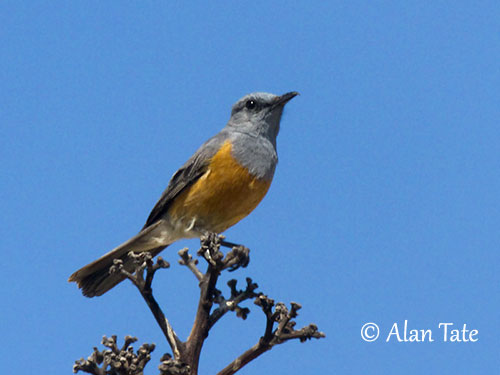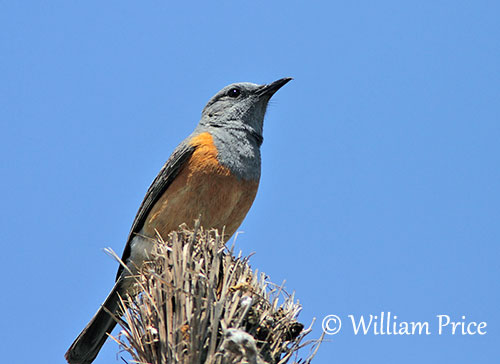
Fr: Monticole du Littoral
Ang: Littoral Rock-Thrush
All: Dünenrötel
Esp: Roquero Litoral
Ita: Codirossone litoraneo
Nd: Duinrotslijster
Sd: dynstentrast
Mal: Tsibotrotsy
Photographers:
John Anderson
John Anderson Photo Galleries
William Price
PBase-tereksandpiper & Flickr William Price
Alan & Ann Tate
AA Bird Photography
Text by Nicole Bouglouan
Sources :
HANDBOOK OF THE BIRDS OF THE WORLD Vol 10 by Josep del Hoyo-Andrew Elliott-David Christie - Lynx Edicions - ISBN: 8487334725
THRUSHES by Peter Clement and Ren Hathway – HELM - ISBN: 0713639407
Birds of Madagascar and the Indian Ocean Islands Par Roger Safford, Adrian Skerrett, Frank Hawkins – ISBN: 1472924118, 9781472924117- Editeur: Bloomsbury Publishing, 2015
The Birds of Africa: Volume VIII: The Malagasy Region: Madagascar, Seychelles, Comoros, Mascarenes - Par Roger Safford, Frank Hawkins – ISBN: 1408190494, 9781408190494- Editeur: A&C Black, 2013
Wikipedia, the free encyclopaedia
Littoral Rock Thrush
Monticola imerina
Passeriformes Order – Muscicapidae Family
INTRODUCTION:
The Littoral Rock Thrush is endemic to Madagascar and can be found in SW and S coastal regions from sea-level up to 200 metres of elevation. It is often perched on shrubs or mound when singing.
This species is sexually dimorphic with bright-coloured male and greyer, duller female.
The Littoral Rock Thrush has restricted range in which it is vulnerable to degradation and destruction of the habitat. However, the species is abundant and currently not globally threatened.
DESCRIPTION OF THE BIRD:
Biometrics:
Length: 16 cm
The Littoral Rock Thrush adult male has pale grey, sometimes tinged bluish-grey, head to upperbreast and upperparts. Rump and uppertail-coverts are slightly paler and duller. The tail is dark brown with narrow, pale bluish-grey edges to outer rectrices, except the outermost. On the upperwing, primary coverts and flight feathers are blackish-brown with fine pale edges in fresh plumage. The greater coverts are dark brown with pale tips and edges in fresh plumage. The alula is dark greyish-black. The dark brown tertials show broader greyish edges.
On the underparts, chin, throat and upperbreast are pale to bluish-grey. Lower part of belly and flanks to underwing-coverts are bright orange, but axillaries are slightly paler. Vent and undertail-coverts are creamy white or washed orange. The thighs are grey with orange flecks.

The entire head and face to nape are pale grey or washed bluish-grey. The lores are darker grey-blue than forehead and face.
The long, slender bill is black, with slightly hooked tip to upper mandible. The eyes are dark brown. Legs and feet are black.
The adult female is duller and greyer. She has head, mantle, back and scapulars pale grey or pale grey-brown. The rump is pale brown, becoming pale orange on the longest uppertail-coverts. The tail is blackish-brown with brownish edges. The wings are brown with fine pale bluish-grey edges.
The underparts are dull buffish or greyish-buff with fine dark scaling. The undertail-coverts are pale whitish buff or tinged orange. On the head, the pale buffish-brown face is finely mottled with whitish spots on chin and throat sides.
The juvenile resembles female but it is heavily mottled whitish on the upperparts. The young male shows orange feathers on lower breast and belly, while progressing towards the adult plumage.
RANGE:
The Littoral Rock Thrush is found in SW and S coastal areas of the island. The species may extend to extreme S corner at Fort Dauphin.
HABITAT:
The Littoral Rock Thrush frequents sub-arid sandy coastal shrubland, including dunes and edges of beaches with Euphorbia stenoclada interspersed with low to medium-sized shrubs, up to 4 metres tall. It is also reported from loosely wooded savanna and areas with Didierea madagascariensis. The species is visible from sea-level up to 200 metres of elevation.
CALLS AND SONGS: SOUNDS BY XENO-CANTO
The Littoral Rock Thrush gives repeated, short, scratchy calls when alarmed, including a quiet « kirr-tak-tak-tak ».
The song consists of repeated, short, scratchy phrases “cheeaar tu-tu-tu” and longer sequences of falling whistles and scratchy notes “crrieer crier whit-sic treeeir whit-sic crieeer treeoeer…”. The territorial calls include mimicry too.
Calls and songs are given from low shrubs or mounds.

BEHAVIOUR IN THE WILD:
The Littoral Rock Thrush can be seen alone or in family group. It feeds usually on berries, fruits and insects. It forages in the open, hoping along ground over vegetation.
If disturbed, it typically flies up to high perch and adopts an upright posture with the head held forwards and the bill pointed upwards. It also spends long periods motionless, perched low in bushes.
During the breeding season, the Littoral Rock Thrush is territorial. They are socially monogamous. The male establishes and defends the territory while the female builds the nest and incubates the eggs.
The Littoral Rock Thrush is sedentary.
It flies with shallow wingbeats but it is able to fly up to high perch if threatened.
REPRODUCTION OF THIS SPECIES:
The breeding season takes place between October and February.
The Littoral Rock Thrush (probably the female) builds a cup-shaped nest with lichens, moss, twigs, plant stems, roots, feathers and bits of snakeskin. The cup is lined with softer material.
The nest is generally suspended among branches and supported below by twigs. It is often placed in Euphorbia stenoclada tree, between 1,50 and 3 metres above the ground.
The female lays 2-3 plain turquoise eggs. In captivity, the nesting period lasts 18 days. Both parents feed the young.
PROTECTION / THREATS / STATUS:
The Littoral Rock Thrush has restricted range in which it is vulnerable to degradation of its preferred scrub habitat. It occurs largely outside protected areas and is vulnerable to clearing of scrub for agriculture expansion, logging and roaming livestock.
However, the species is not globally threatened and the population appears to be stable. The Littoral Rock Thrush is currently evaluated as Least Concern.